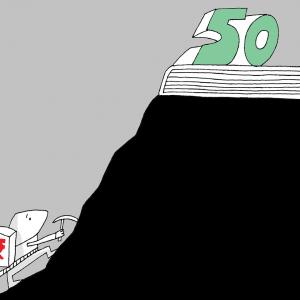The impact of currency depreciation can be mitigated by holding a portion of your investment portfolio in dollar-denominated assets.

Over the past year, the rupee has depreciated 3.07 per cent while over three years it has declined at an annualised rate of 4.18 per cent against the US dollar.
Driven by trade deficit
The massive demand for the US dollar is a key reason for the rupee's weakness.
"India requires huge amounts of imports on a continuous basis. Our exports, by comparison, are small. Hence, our trade position doesn't support a strong rupee," says Joseph Thomas, head of research, Emkay Wealth Management.
Interest rate differential also plays a part.
"During times when interest rates in the US rise rapidly within a short period, capital flows out of India as foreign portfolio investors prefer to invest in the US, instead of emerging markets, debt," says Abhishek Kumar, a Securities and Exchange Board of India or Sebi-registered investment advisor and founder, SahajMoney.
Goals that get impacted
A number of parents want to send their children abroad for graduate and post-graduate education.
International travel is also high on the priority list of many Indians.
Some parents also want to support their child, who has moved to the US, in purchasing a house.
"Non-resident Indians, who have invested the bulk of their money in India, but propose to stay abroad after retirement, would also bear the brunt of a sharp depreciation," says Deepesh Raghaw, a Sebi RIA.
Plan for depreciation
If you have dollar-denominated goals, you need to factor currency depreciation into your financial planning.
"Suppose you plan to send your child to the US for higher education where education inflation is, say, 5 per cent. And you wish to factor in a 4 per cent annual currency depreciation rate.
"So, plan for a 9 per cent increase each year in the value of this goal," says Vishal Dhawan, chief financial planner, Plan Ahead Wealth Advisors.
Investors who have not done such planning will have to defer their goal, alter its frequency, or divert money saved for other goals.
In the case of child's education, which can't be deferred, the only option is to divert money from another goal.
In the case of travel, you can go every, say, three years instead of two.
Alternatively, you could opt for a less expensive destination or one where the currency impact is less pronounced.
The impact of currency depreciation can also be mitigated by holding a portion of your investment portfolio in dollar-denominated assets.
Invest in international funds
When you invest in an international fund-of-fund, your rupee investment gets converted to dollar.
The dollar amount is used to buy units of the parent fund. When you sell, those units get sold.
The dollar amount obtained is converted into rupee. Because of the rupee's depreciation, the amount you obtain is higher.
Investors can also take the Liberalised Remittance Scheme (LRS) route and remit $250,000 abroad annually.
This route opens up a massive number of international equity and debt exchange-traded and index funds, active funds, and stocks, but tax compliance becomes more onerous.
"When investing in international equities, have at least a 7 to 10-year horizon. If valuations in the US market are high, take the systematic investment plan route," says Dhawan.
Don't allow recency bias to affect you. It is impossible to predict whether Indian or US equities will outperform in the future.
"If 20 per cent of the money you require will be for international goals, then have 20 per cent of your portfolio in international assets," says Dhawan.
Take exposure to yellow metal
Gold is priced in US dollars in the international market.
"Its Indian price is a function of its international price and exchange rate (plus import duty). When the rupee depreciates against the US dollar, the currency hedging happens automatically," says Kumar.
Gold is a speculative asset. "It doesn't generate cash flows. Its price is purely a function of demand and supply," says Raghaw.
It can also be quite volatile. Kumar suggests allocating 5 to 10 per cent of your portfolio to gold.
Invest with a long-term horizon as the yellow metal can underperform for long periods.

Disclaimer: This article is meant for information purposes only. This article and information do not constitute a distribution, an endorsement, an investment advice, an offer to buy or sell or the solicitation of an offer to buy or sell any securities/schemes or any other financial products/investment products mentioned in this article to influence the opinion or behaviour of the investors/recipients.
Any use of the information/any investment and investment related decisions of the investors/recipients are at their sole discretion and risk. Any advice herein is made on a general basis and does not take into account the specific investment objectives of the specific person or group of persons. Opinions expressed herein are subject to change without notice.
Feature Presentation: Ashish Narsale/Rediff.com










